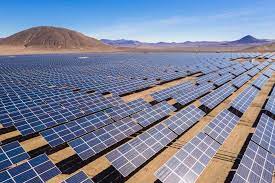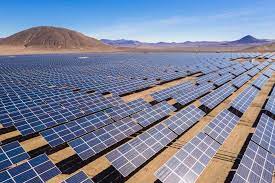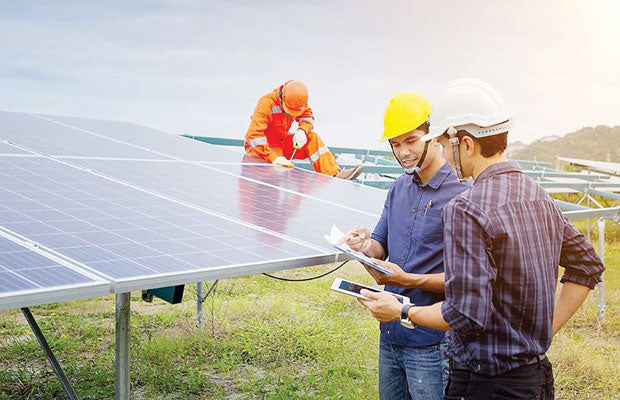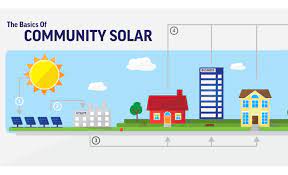
Deciding where solar projects will be installed is one of the very first decisions to be made in a project development timeline. While residential solar is most commonly found on rooftops, utility-scale and other large-scale solar projects have much more flexibility for siting. As the United States works toward decarbonizing the electricity system by 2035, solar capacity will need to reach one terawatt (TW), which will require more diversity of siting configurations. There is approximately 115 TW of solar photovoltaic potential in the U.S., which includes 1 TW on buildings, 27 TW on agricultural land, 2 TW on brownfields, and 2 TW for floating solar.
The U.S. Department of Energy Solar Energy Technologies Office (SETO) conducts research to reduce the cost and impact of siting solar. We’ve answered some common questions about large-scale solar siting below.
WHAT MAKES LAND OPTIMAL FOR LARGE-SCALE SOLAR GENERATION?
Solar panels work everywhere in the United States, but some areas have more sunny, clear days than others, which means more energy production. Other factors to consider are the elevation of the land (the flatter, the better) and proximity to transmission lines and the point of electricity consumption (the closer, the better).
WILL THE PERMITTING PROCESS VARY DEPENDING ON WHERE LARGE-SCALE SOLAR IS PROPOSED?
Yes. Each locality in the United States has different laws and regulations in place pertaining to the siting of large-scale solar facilities A SETO-funded project, led by The International City/County Management Association, is bringing together public- and private-sector stakeholders to identify best practices for local governments, special districts, and other authorities that permit large-scale solar projects. They are developing tools and resources for procedures, analysis, and communications related to permitting, zoning, regulations, and planning for these installations, especially on public and municipal lands, on brownfields, and in rural areas. The team will ultimately disseminate this information through workshops, trainings, and other programming.
CAN SOLAR BE INSTALLED ON BROWNFIELDS?
According to the Environmental Protection Agency (EPA), a brownfield is a property that has or may have hazardous substances, pollutants, or contaminants present. It is estimated that there are more than 450,000 brownfields across the country. Examples of brownfields include landfills at capacity, abandoned mines, and formal industrial sites. While brownfields might not be appropriate for housing development, they present economic opportunities for solar energy production.
The EPA’s RE-Powering America’s Land initiative encourages renewable energy development on current and formerly contaminated lands, landfills, and mine sites when such development is aligned with the community’s vision for the site. The EPA has also worked with the National Renewable Energy Laboratory to provide guidance on how to best redevelop brownfields for solar. Download the Best Practices for Siting Solar Photovoltaics on Municipal Solid Waste Landfills.
CAN SOLAR PANELS FLOAT ON BODIES OF WATER?
Yes, though it’s not very common yet in the United States. The National Renewable Energy Laboratory conducted a study to investigate floating PV’s potential and found that 27% of man-made bodies of water are suitable for solar. Many of these eligible bodies of water are in water-stressed areas with high land acquisition costs and high electricity prices, so using floating PV may be a strategic way to enable more people to benefit from solar energy while lowering costs. Additionally, researchers found that floating PV can lead to reduced evaporation and algae growth and can lower PV operating temperatures, potentially improving panel performance.
SETO is investigating floating PV through research at the University of Central Florida that is gathering data to assess the performance of floating PV and the ecological impacts to aquatic ecosystems.
DO SOLAR PANELS INCREASE STORMWATER RUNOFF FROM A SITE?
If not properly managed, solar facilities can cause stormwater runoff from the site or soil erosion of the land underneath. Some site management practices include site grading and terracing, vegetation under the panels, and retention ponds. SETO funds a project led by the National Renewable Energy Laboratory called Photovoltaic Stormwater Management Research and Testing. The team is conducting field research on stormwater infiltration and runoff at solar installation sites that will be used to validate a model to predict runoff for a range of site conditions and PV designs. The team will also identify best practices for stormwater management at ground-mounted solar sites.
DO LARGE-SCALE SOLAR FACILITIES IMPACT BIRDS?
The scale of the impact of large-scale solar facilities on birds isn’t well understood. Several of SETO’s projects are using data-driven approaches to study the issue. These include the use of high-definition cameras and deep learning technology to develop automated detection of avian-solar interaction, monitoring birds at solar facilities using drones and 3-D imaging, and applying new genetic-based methodologies to characterize feathers recovered from solar energy facilities by species and population of origin. Another project managed by the National Labs resulted in the Avian-Solar Science Coordination Plan, which identifies and prioritizes avian-solar research needs to inform future decisions that will reduce impacts of large-scale solar energy development on birds.
IS IT POSSIBLE TO COMBINE FARMING WITH SOLAR ENERGY GENERATION?
Yes. Co-locating agriculture and solar on the same land is often called “agrivoltaics.” SETO, which has been funding research on agrivoltaics since 2015, defines the practice as crop production, livestock grazing, and/or pollinator habitat beneath or adjacent to solar panel. Through NREL’s Innovative Site Preparation and Impact Reductions on the Environment (InSPIRE) project, research is being carried out at 29 sites across the country, including at both universities and commercial solar facilities.
Depending on the crop type and solar panel configuration, crops can grow well under solar panels, because they still receive sufficient sunlight. In areas with high heat, like the desert southwest, the shade could even keep plants cooler reduce water stress and have a positive impact on crop productivity. Research on growing crops under PV panels in the drylands in Arizona found up to a 3-fold increase in crop yield, depending on the crop type, a 50% reduction in irrigation requirements, and a 2% increase in solar panel performance. In Minnesota, research on growing pollinator habitat under PV panels found three times more beneficial plant species, a four-fold increase in pollinator insects, higher energy output from the PV panels, and less mowing required at the solar facilities, which can help lower operations and maintenance costs.
Growing pollinator habitats under solar panels is becoming more common in the United States. More than 150 solar facilities have pollinator habitats grown onsite, but most of these sites are less than 20 megawatts in size. Fifteen states have guidelines for seed mixes and management practices. Growing crops under solar panels is not as common and is mostly done at research sites. One commercial solar-crop site operates in Colorado; other sites are being planned in Massachusetts and California.
Grazing of some types of animals, such as sheep, rabbits, and even cattle, under solar panels is also possible. Members of the American Solar Grazing Association are developing best practices for the use of grazing sheep on solar installations to manage vegetation.



